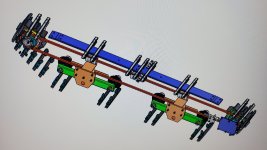One day I want to make a differential steering vehicle that, rather than using brakes on either side, uses a variator. If you're unfamiliar with a variator it's basically a CVT that, instead of changing its ratio dynamically based on RPM/torque, is directly controlled by the user.
The way it works in my head is:
- Power is transferred to the tracks via a normal differential.
- On either side of the differential, inboard of the track, where the brake would normally be, instead there is a variable pulley.
- These two variable pulleys are coupled via CVT belts (picture snowmobile belt) to a common intermediate shaft with complementary variable pulleys.
- When the vehicle is going straight, both variators are at 1:1 ratio and the intermediate shaft just idles at the same speed as the axle shafts.
- When turning, the intermediate shaft will shift to one side, opening its variable pulley on one side and closing the variable pulley on the other side.
- This will (in my head) take speed from one side and, rather than wasting it as heat, divert/add it to the other side.
I know that a differential already does that (divert speed from one side to the other) but only in response to unequal torque, normally achieved by differential braking. I think this system would merely assist the differential in doing what it's already made to do, and allow it to do its job without wasting (much) power. In addition to eliminating the bulk of the waste power, I think it would make for a much more stable vehicle at high speed. The differential would be more or less "locked in" to certain ratio (left:right) as if by gearing, rather than be at the mercy of however the brakes feel like responding depending on how hot or worn they are.
I think you could conceivably get rid of the differential altogether with a similar variator-controlled setup, but then the variators would need to be much more robust as they would bear the entirety of the drive power. In the system I described above, I think the power of locomotion would be transmitted 100% by the differential and the only power that the variator system would be responsible for transmitting is that which results from the friction between the two tracks whenever not going straight. I'm not totally certain of this but like I said, that's how it works in my head.

